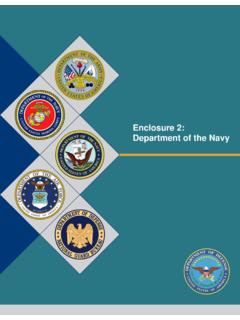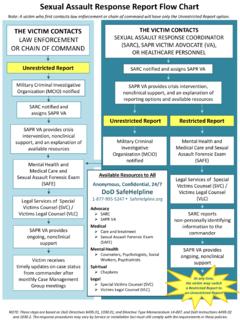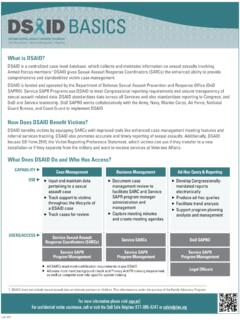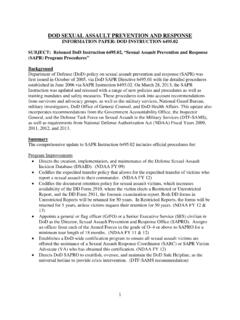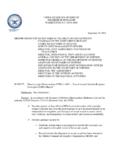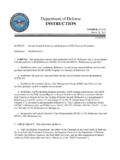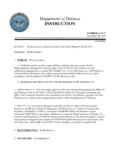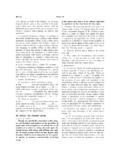Transcription of Enclosure 1: Department of the Army Report - SAPR
1 Enclosure 1: Department of the Army Report Fiscal Year 2020 LOYALTY DUTY RESPECT SELFLESS SERVICE HONOR INTEGRITY PERSONAL COURAGE DoD Safe Helpline: 1-877-995-5247 TABLE OF CONTENTS Executive Summary .. 1 1. Goal 1 - Prevention .. 5 2. Goal 2 - Victim Assistance and Advocacy .. 8 3. Goal 3 - investigation .. 17 4. Goal 4 - Accountability .. 21 5. Goal 5 - Assessment .. 28 6. Core Functions: Communication and Policy .. 32 7. National Defense Authorization Act (NDAA) Requirements .. 35 8. Analytics Discussion .. 36 Sexual Assault Data Spreadsheets 1. Army Sexual Assault Unrestricted Report Data .. 45 2. Army Sexual Assault Restricted Report Data .. 54 3. Support Services for Victims of Sexual Assault.
2 56 4. Combat Areas of Interest (CAI) Unrestricted Report Data .. 59 5. CAI Restricted Report Data .. 66 6. Support Services for Victims of Sexual Assault in CAI .. 68 7. Unrestricted Report Sexual Assault Case Synopses .. 71 Appendix A: Glossary of Acronyms .. A-1 1 Executive Summary: Fiscal Year 2020 Annual Report on Sexual Assault in the Military ( ARMY) The Army is committed to enhancing readiness by preventing sexual assault, sexual harassment, and associated retaliatory behaviors and by providing comprehensive response capabilities through its Sexual Harassment/Assault Response and Prevention (SHARP) program. To accomplish this commitment, Army leaders must establish a culture of dignity and respect that does not tolerate behaviors and attitudes that lead to sexual misconduct and in which victims feel safe to Report without fear of retaliation.
3 The vast majority of Soldiers serve honorably, meeting the standards embodied in the Army Values. However, it is the unacceptable actions of a few that jeopardize unit readiness and erode the trust and confidence that the American people have in our Army. Soldiers who commit the crime of sexual assault, or fail to intervene and stop an assault, violate the Nation s trust and the trust of their fellow Soldiers. To retain the trust and confidence of the Nation, the Army embeds its efforts in a SHARP program that combines initiatives to prevent and respond to incidents of sexual assault, sexual harassment, and retaliation. In fiscal year 2020 (FY20), the Army continued to see a high rate of sexual assault reports: reports of sexual assault per 1,000 Soldiers, unchanged from FY18 and FY19, and the highest reporting rate ever recorded.
4 Despite the continued high rate, the Army saw a decrease in the reporting during the third quarter of FY20, likely due to COVID-19. Many Army units reported some behaviors and activities associated with sexual assaults were limited by COVID social distancing mandates and restrictions on businesses and activities involving large gatherings. Nevertheless, the sustained high rate in the number of reports may reflect victim confidence in their chain of command, victim advocacy and response services, Army criminal investigation offices, and appropriate accountability for offenders. However, results of the most recent Department of Defense (DoD) Workplace and Gender Relations Survey of Active Duty Members (WGRA) showed an increase in the estimated prevalence of sexual assault to 6,500 Army Soldiers in 2018, compared to 5,200 estimated in 2016.
5 This increase is very troubling and shows that the Army s sexual assault prevention strategies have not achieved their intended results. During FY19 and FY20, the Army re-examined these strategies in an effort to reduce prevalence and prevent sexual assault. DoD postponed the 2020 WGRA until 2021, due to COVID-19. This Report details the operational initiatives of the Army s SHARP program and the Army s progress in preventing and responding to the crimes of sexual assault. Highlights of the Army s FY20 initiatives and progress include: Completed a plan of action and milestones that incorporates specific objectives in support of a comprehensive prevention strategy. Maintained a professionally trained cadre of sexual assault response coordinators (SARCs) and victim advocates (VAs) as critical resources who enable coordination between commanders and other agencies to ensure the best possible response to victims.
6 "What I need every leader to do is teach our Soldiers, to teach our leaders, that they must intervene. That needs to become part of our culture . General James C. McConville 40th Chief of Staff of the Army 2 Maintained highly-trained, qualified, and experienced special victim investigators to lead sexual assault investigative teams throughout the Army. Completed the implementation of a comprehensive military justice redesign to ensure the most effective allocation of judge advocate resources to both special victim and general crimes cases. Continued to implement a strategic oversight plan to facilitate the assessment of the SHARP program. Since its inception in 2009, the Army s SHARP program focused its efforts on addressing specific goals which align with the five goals of the Department of Defense Sexual Assault Prevention and Response (SAPR) Strategic Plan, 2017-2021: Goal 1 - Prevention of sexual assault.
7 Goal 2 - Assistance to, and advocacy for, victims of sexual assault. Goal 3 - Competent and sensitive investigations of sexual assault. Goal 4 - Accountability for the alleged perpetrators of sexual assault. Goal 5 - Effective assessment of the SHARP program. In addressing Goal 1 (Prevention) during FY20, the Army developed a plan of action and milestones in support of Phase II of the DoD Prevention Plan of Action (PPoA). In addition, the Army published a prevention annex to the Army People Strategy. The annex directly aligns with the PPoA and outlines a comprehensive framework for the prevention of sexual assault using a public health approach. The Army is dedicated to victim care and response through Goal 2 (Victim Assistance and Advocacy). Army SARCs and VAs receive comprehensive training through a 2-week SHARP Foundation Course (conducted locally for collateral duty personnel) or a 6-week SARC/VA Career Course (for full-time personnel) from the Army SHARP Academy at Fort Leavenworth, Kansas.
8 The Army also ensures that victims of sexual assault receive quality medical care at Army military treatment facilities (MTFs). The Army Medical Command (MEDCOM) provides at least one sexual assault medical forensic examiner (SAMFE) at every Army MTF equipped with an emergency room. The Army addresses Goal 3 ( investigation ) with innovative techniques and state-of-the art resources to ensure the thoroughness of sexual assault investigations. The Army Criminal investigation Command (CID) joins with prosecutors, victim witness liaisons, SARCs, VAs, and other sexual assault responders to form special victim capability teams at Army installations worldwide. These teams train in the unique aspects of investigating and prosecuting sexual assault cases. The Army Military Police School continues to increase the Army s number of certified agents through an acclaimed sexual assault investigative training program.
9 Highlights of efforts in Goal 4 (Accountability) during FY20 include the completion of a comprehensive redesign of military justice which, by specializing counsel as litigators or command advisors, improves both the expertise in the courtroom and the quality of legal advice to commanders. Also in FY20, the special victim prosecutors (SVP) program added five new positions to meet special victim caseload targets. 3 The objective of Goal 5 (Assessment) is to measure, analyze, and assess the effectiveness of the Army s efforts related to sexual assault prevention and response. The Army collects information from multiple sources to determine the effect of its actions and initiatives to mitigate sexual assault. For FY20, the Army continued to provide measures of effectiveness to Army commands and installations in support of their mitigation action plans to counter sexual assault vulnerabilities identified in their organizations.
10 In addition, the Army continued a force-wide staff assistance visit (SAV) program designed to capture qualitative data to complement the quantitative data collected by organizational inspections. Leaders at all levels must take an active role in the SHARP program to ensure that the Army achieves these five stated goals. Leaders must establish command climates that prevent the crime of sexual assault, take all allegations of sexual assault seriously, ensure fair and impartial investigations, treat victims with dignity and respect, and ensure that victims can Report without fear of retaliation, while taking appropriate action against alleged offenders. Significant elements of the Army SHARP program include: A senior commander at each Army installation who has overall responsibility for SHARP program implementation and execution.
